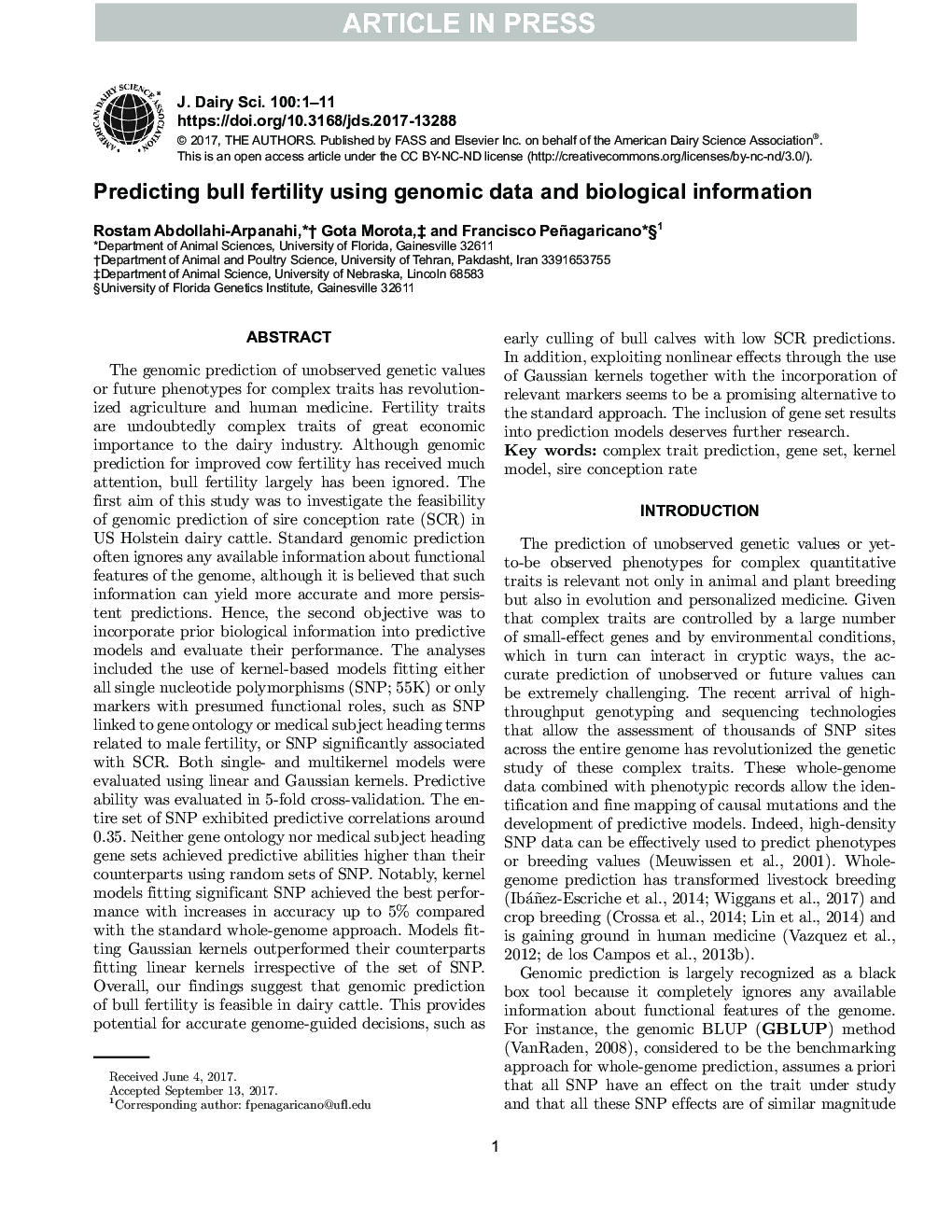| کد مقاله | کد نشریه | سال انتشار | مقاله انگلیسی | نسخه تمام متن |
|---|---|---|---|---|
| 8501634 | 1553845 | 2017 | 11 صفحه PDF | دانلود رایگان |
عنوان انگلیسی مقاله ISI
Predicting bull fertility using genomic data and biological information
ترجمه فارسی عنوان
پیش بینی باروری بوقلمون با استفاده از اطلاعات ژنتیکی و اطلاعات بیولوژیکی
دانلود مقاله + سفارش ترجمه
دانلود مقاله ISI انگلیسی
رایگان برای ایرانیان
کلمات کلیدی
پیش بینی صفت پیچیده، ژن مجموعه، مدل هسته، نرخ تخمک زایمان،
موضوعات مرتبط
علوم زیستی و بیوفناوری
علوم کشاورزی و بیولوژیک
علوم دامی و جانورشناسی
چکیده انگلیسی
The genomic prediction of unobserved genetic values or future phenotypes for complex traits has revolutionized agriculture and human medicine. Fertility traits are undoubtedly complex traits of great economic importance to the dairy industry. Although genomic prediction for improved cow fertility has received much attention, bull fertility largely has been ignored. The first aim of this study was to investigate the feasibility of genomic prediction of sire conception rate (SCR) in US Holstein dairy cattle. Standard genomic prediction often ignores any available information about functional features of the genome, although it is believed that such information can yield more accurate and more persistent predictions. Hence, the second objective was to incorporate prior biological information into predictive models and evaluate their performance. The analyses included the use of kernel-based models fitting either all single nucleotide polymorphisms (SNP; 55K) or only markers with presumed functional roles, such as SNP linked to Gene Ontology or Medical Subject Heading terms related to male fertility, or SNP significantly associated with SCR. Both single- and multikernel models were evaluated using linear and Gaussian kernels. Predictive ability was evaluated in 5-fold cross-validation. The entire set of SNP exhibited predictive correlations around 0.35. Neither Gene Ontology nor Medical Subject Heading gene sets achieved predictive abilities higher than their counterparts using random sets of SNP. Notably, kernel models fitting significant SNP achieved the best performance with increases in accuracy up to 5% compared with the standard whole-genome approach. Models fitting Gaussian kernels outperformed their counterparts fitting linear kernels irrespective of the set of SNP. Overall, our findings suggest that genomic prediction of bull fertility is feasible in dairy cattle. This provides potential for accurate genome-guided decisions, such as early culling of bull calves with low SCR predictions. In addition, exploiting nonlinear effects through the use of Gaussian kernels together with the incorporation of relevant markers seems to be a promising alternative to the standard approach. The inclusion of gene set results into prediction models deserves further research.
ناشر
Database: Elsevier - ScienceDirect (ساینس دایرکت)
Journal: Journal of Dairy Science - Volume 100, Issue 12, December 2017, Pages 9656-9666
Journal: Journal of Dairy Science - Volume 100, Issue 12, December 2017, Pages 9656-9666
نویسندگان
Rostam Abdollahi-Arpanahi, Gota Morota, Francisco Peñagaricano,
